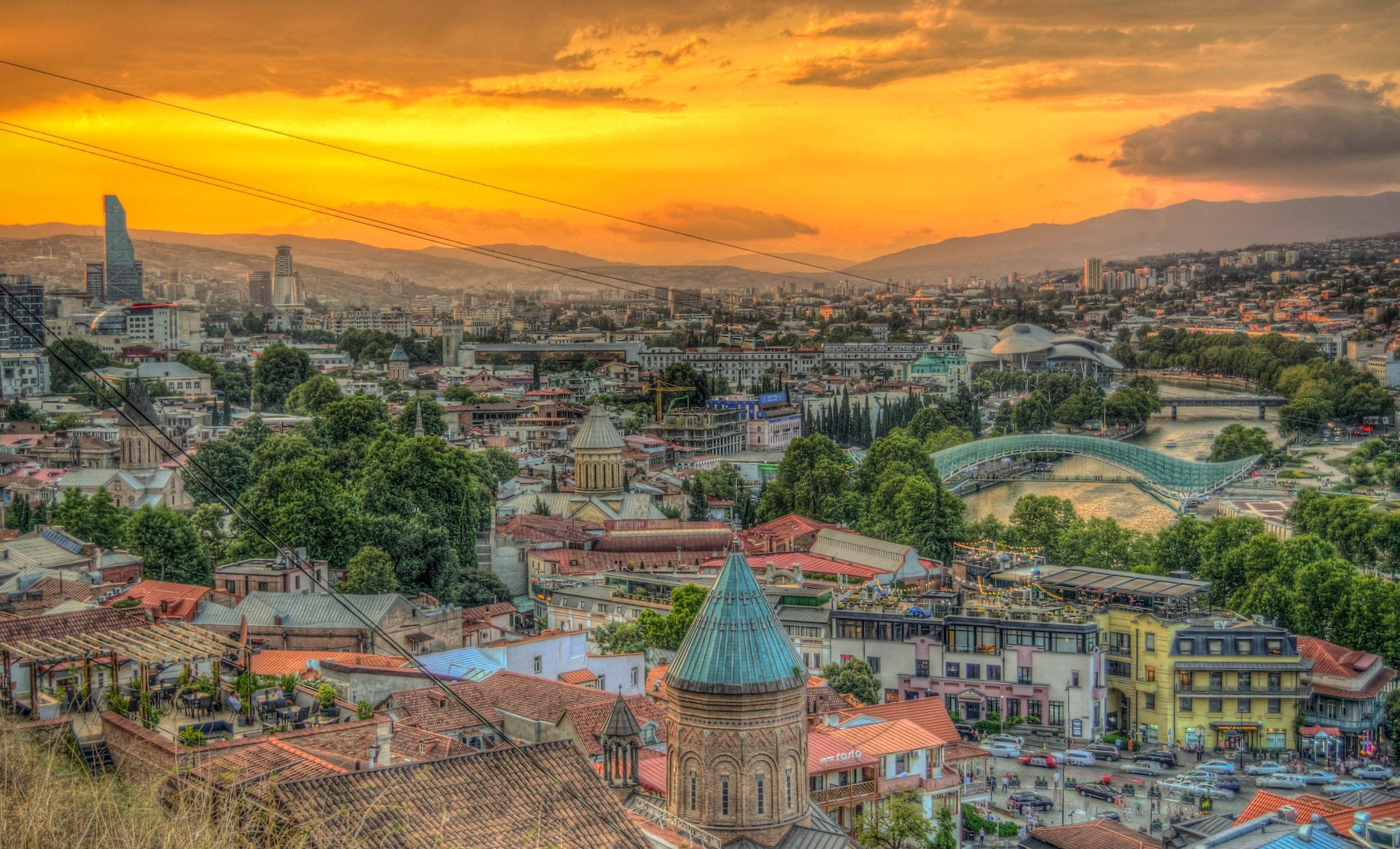Proven information on accommodation, transport, dining and tips for excursions! If you're heading to Tbilisi, the capital of a country that was among the first to adopt Christianity as its religion, be sure to read our city guide! The contrasting mix of old Christian monuments standing side by side with the most modern architectural buildings, the clutter, the semi-decayed colourful houses with their typical glass bay windows next to wide green boulevards, the excellent cognac, the ubiquitous Georgian script and the music echoing through the streets. Surrounded by mountains, the city's somewhat unusual shape hugs the waters of the Kura River for 25 kilometres. Where to go in the city, what to see, what to eat and what not to eat? This guide provides inspiration for visiting the more famous, but also the more tucked away corners of this Caucasian metropolis.
Arrival and transport
Georgia is becoming an increasingly popular holiday destination, with plenty to offer adventurers and more comfortable travellers alike. More and more airlines are offering flights to the country at affordable, and often ridiculously cheap, prices.
Transportation from/to the airport:
From Tbilisi airport you have the option to use one of the local taxis, the price is around 30 GEL and takes about 30 minutes. Always negotiate the fare in advance to avoid unnecessary arguments with taxi drivers, you can use the Bolt (Taxify) mobile app to find out the fare in advance.
There's also public bus line 37, running every half an hour between the airport and the main station, which is less than four kilometres north of the old town (it's in the Didube district, where you can handily travel further into the country). You can buy tickets directly from the bus driver for 0.5 GEL.
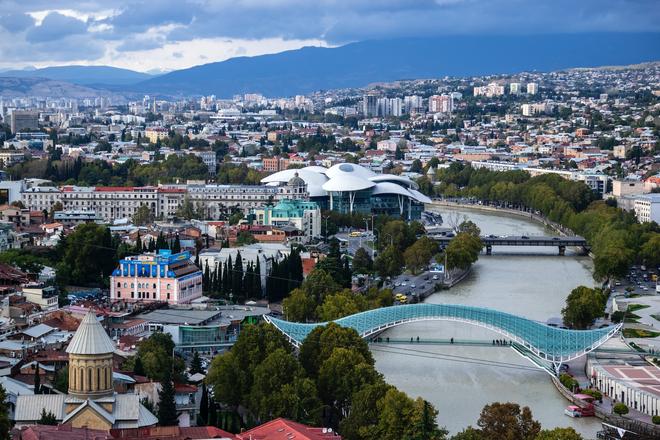
The third option is the train, and the price and destination are similar to the bus. It departs from a new station that has been built about 100 metres from the airport terminal.
Public transport in Tbilisi
There are various transport options around the city, but the most convenient is the local metro. There are two lines, running from 6am to midnight, connecting the most important parts of this relatively long city. You buy a portable Metromoney card for 2 GEL, where you load a sum of money and it then works as a prepaid card. It can be returned undamaged within 30 days of sale – as long as you have the receipt.
Another option is the public transport line buses, which run from 7am to midnight for the same price.
The shuttles are special because they don't have permanent stops – the driver will drop you off practically anywhere you ask. However, you need to make sure you know where the vehicle is going. You can buy a ticket for 0.8 GEL from a machine inside the shuttle (the machine does not refund), and in the newer yellow cars you can also pay with a Metromoney card by attaching it to the machine.
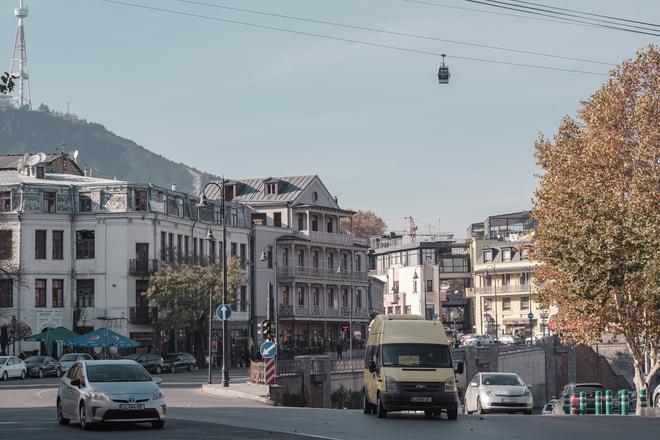
A highlight is the cable car, there are two in town. One runs from Rike Park in the Old Town to Narikala Fort (2.5 GEL), the other from Vake Park to Turtle Lake (1 GEL). You can also ride the Tbilisi Funicular going to Mtatsminda theme park.
Orientation in Tbilisi
The centre of the action and the main thoroughfare of the city is Rustaveli Avenue. In its northern extension along Merab Kostava Boulevard is the small Tbilisi Zoo.
If you head south along the aforementioned Rustaveli Avenue, you'll pass dozens of cafes, clubs and restaurants. At the northern end of Rustaveli stands the monument to Shota Rustaveli, the Georgian poet, under which is an open space that is a frequent meeting place for the city's residents. There are plenty of stalls and vendors selling various trinkets, locals hold various dance or singing parties here, and about 100 metres to the east, in Rose Revolution Square, you can appreciate a giant metal bicycle. There's also a nice view of Mtatsminda with a giant Ferris wheel and the Academy of Sciences in the foreground.
Rustaveli Avenue will slowly lead you to the neoclassical Freedom Square, along the way the Georgian Parliament building with its distinctive columned facade will catch your eye, across the street is the National Museum. To the east of the square is Kote Afkhazi Street, which takes you into the old town below. Dozens of old streets run off the sides of this avenue, reliably carrying forward the soul of old Tbilisi. The houses have the typical glazed and weathered wooden bay windows, and the alleys twist in odd shapes making it a little difficult to find your way around, while to the east is a more modern, artsy area, full of bars, restaurants and cafes, where you may also come across the local modern leaning Clock Tower.
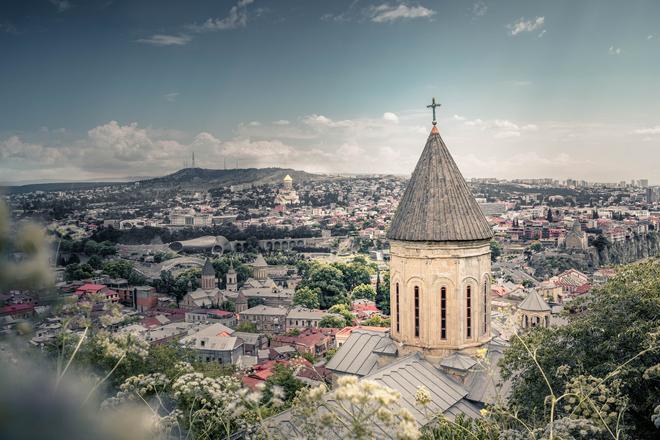
Along Kote Afkhazi there are many shops, snack and souvenir stalls, and countless wine bars offering the famous Kachetin wine. A few steps below will lead you to the old Meidan, a small square on the Kura waterfront that offers views of Narikala and across to the other bank, to the statue of national hero King Vakhtang Gorgasali, a Christian nobleman who ruled the country from the age of seven in Byzantine times. Overhead, a new ropeway leads to the fortress above the town.
Where to eat
When it comes to dining, Georgia is the top destination for food in the region. If you visit a more traditional local restaurant or eat privately with locals, you're likely to encounter traditional Georgian dining. This usually consists of rather lavish feasts, where the host places bowls of individual courses on the table and then everyone serves themselves. The food tends to be very varied and the flavours distinctive.
Traditional dishes: meat and cheese
You will find shashlik made from mutton or beef. The exception to this are the boiled pouches filled with spiced minced meat known as chinkali. A classic local delicacy is Georgian puri bread, which comes in many forms. The better-known versions include khachapuri, which resembles a cake filled with cheese or meat, or ajaruli, a kind of boat-shaped cake filled with cheese and egg.

Minced meat is served by Georgians in many forms, boiled doughnuts wrapped in a wine leaf, shashlik or stuffed into many different doughs. The ultimate delicacy, which you must try at least once, is chicken Satsivi with a delicious nutty garlic sauce. For a side dish, you can opt for a bowl of vegetable salad and finish with a sweet spot of nuts strung on a thread wrapped in a rubbery grape juice crust. You can buy these on almost every corner in town.
Restaurants in Tbilisi
In the historic centre of the city, it's no problem to eat in any restaurant, and you'll usually be tempted by signs on the streets, which usually include prices. Personally, I appreciate Bread and Wine restaurant just a short walk from the Rustaveli metro stop serving traditional Georgian food, homemade Georgian dishes made with fresh and natural ingredients. The stylish Sormoni restaurant can be found on Alexander Kazbegi Avenue. Meama Restaurant on the banks of the Kura River offers typical Georgian cuisine. Bina N37 is located on the rooftop veranda on the 8th floor of an apartment building, where you can taste Georgian wine from qvevries (clay pots).
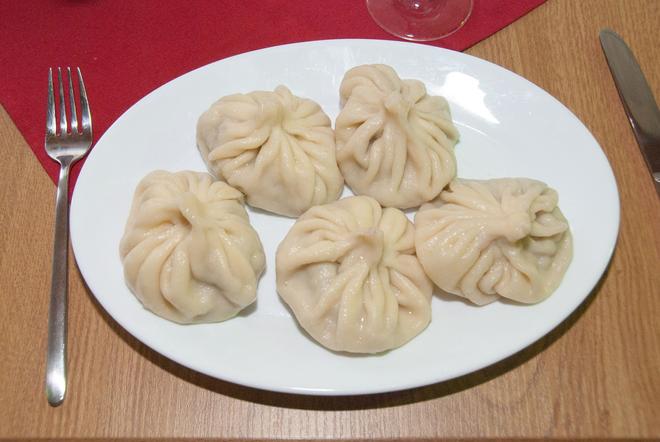
What I found hard to pass up was the minced meat in a pie, which I had covered with sauce basking in the Georgian summer sun at one of the street stalls on Kote Abkhazi. But watch out; my stomach paid the price for this the following week!
Authentic flavours
If you want to get away from the more well-trodden places and try something more authentic, we found it worthwhile to walk out to the less-visited parts of Didube. You can use this option if you have a lot of time before the train or bus leaves, for example. The neighborhood is a bit wilder and there are fewer Latinos, but the experience will be all the more powerful for it.
Alcohol
Tasting local alcohol is an experience in itself; for a few shekels you can get extremely high quality vodka, and the famous Kachetin wine. The most famous local drink is aged and produced in very specific conditions in the areas bordered by the Lesser and Greater Caucasus. Since 2013, the local wine processing method has been part of the UNESCO World Heritage Site. Another delicacy for the discerning consumer is the excellent Georgian cognac, the prices are reasonable and you will certainly enjoy the basic VS Sarajishvili, which you can buy much more cheaply in Tbilisi than at home.
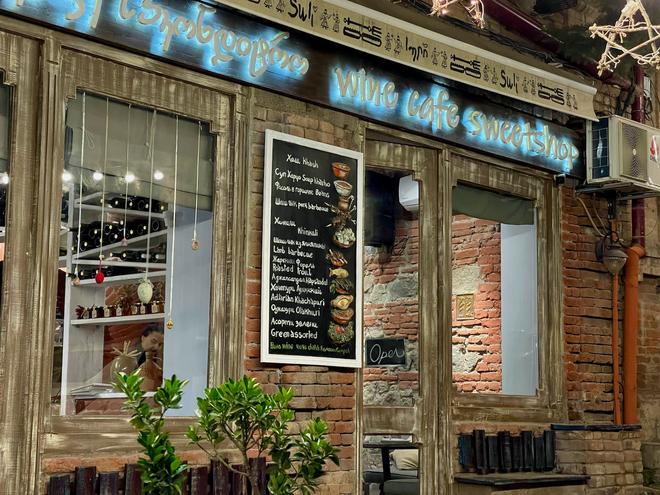
There are also several places in Tbilisi that serve soda water with syrup as a traditional drink, made by Lagidze Water, which was invented in the late 19th century by the Georgian pharmacist Lagidze. Be sure to try this pleasant refreshment.
Where to stay in Tbilisi
There are as many accommodation options in Tbilisi as in any capital city. It's best to plan your accommodation in advance. If you're looking for local accommodation, the most tourist-friendly area is the area immediately adjacent to Kote Afkhazi. It's in the heart of the Old City, so expect slightly higher prices, but almost everything essential is within walking distance and you'll find dozens of hostels, guesthouses and hotels equipped to European standards, often with typical courtyards adorned with balconies and bay windows.
large concentration of hotels, family-run hotels, apartments and hostels can also be found on the west bank of the Kura River along the two main streets of Rustaveli Avenue and Pekini Avenue.
Tbilisi is a city of contrasts and the variety of accommodation is also great – modern buildings of multinational hotel chains such as Marriott, Radisson Blu, Ramada, Best Western and Mercure stand next to the cheapest hostels, while smaller family-run guesthouses offer accommodation in the city's original buildings.
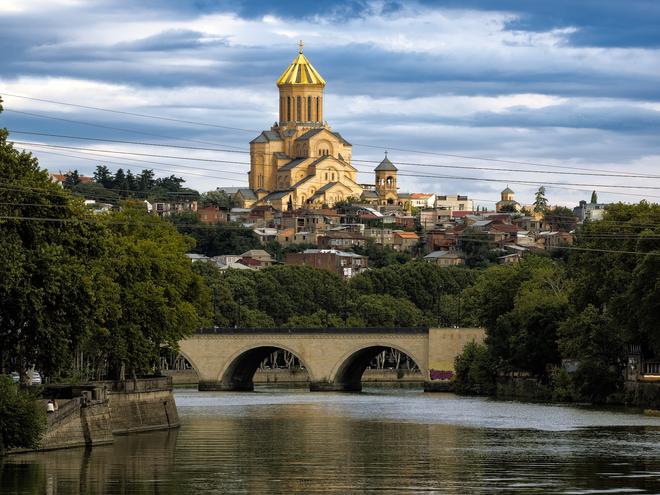
The Tbilisi Factory is built in a former Soviet fabric factory in the historic part of Tbilisi and has its own courtyard with cafes and bars, art studios and workshops as well as a creative school, shops and a barber shop. A unique atmosphere here is created by the old concrete walls and industrial elements that blend with modern style. It provides accommodation in well-equipped private or shared rooms.
The modern Tbilisi Park Hotel is surrounded by greenery, offers a tennis court and rooms with private bathrooms. The hotel's restaurant serves a selection of European cuisine.
The Tiflis Inn Boutique Hotel is decorated in 19th-century style and is located on the ground floor of a historic building. It features a restaurant and a bar. The modern Moxy Tbilisi by Marriott is also interesting, with a garden and bar.
More modest but good-quality accommodation is provided by Gela's Apartment, Bany Guest house and Hotel Kristina.
Nightlife
The nightlife in Tbilisi is very lively, the streets are full of young people and there are many interesting bars and clubs that are definitely worth a visit. The streets near the river are the liveliest – especially Chardeni and Erekle II, while Perovskaya and Rustaveli are also bustling.
If you're a fan of more relaxed evenings, visit Carpe Diem cafe bar – a cute little hilltop cafe in the centre of old Tbilisi. For a stunning view of the city and a relaxed atmosphere, head to SKY7 Terrace and Lounge Bar. If you love wine, don't miss the Old Cellar on your discovery tour of Tbilisi. An excellent place for entertainment and nightlife can be found at Soul Train Bar.
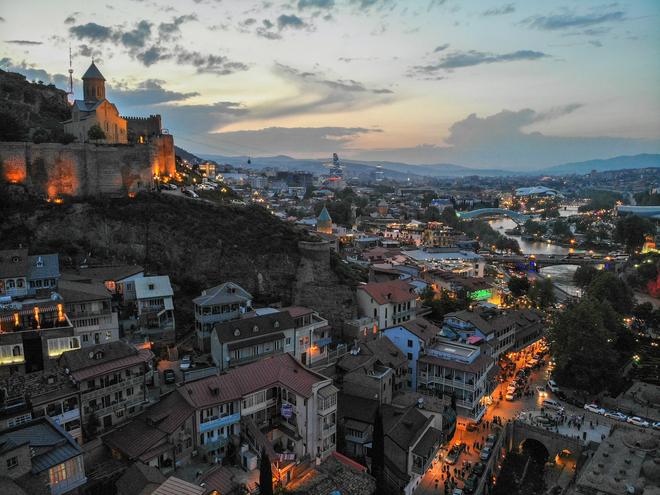
If you advocate a more active kind of entertainment and are eager to dance, visit Meoba Bar or DIVE x Fabrika.
Shopping
In Tbilisi, you'll find two shopping malls, East Point and Tbilisi Mall, located at different ends of the city. On Rustaveli Avenue you can find the Merani shopping gallery. If you're looking for fashion shops or want to bring back a hand-woven rug from Tbilisi, head to Kote Abkhazi Street.
The best place for souvenirs is the local flea market on “Dry bridge”, not far from the centre. You can buy antiques, jewellery and collectibles, interesting books, and old coins, among other things.
A nice souvenir is a jazva, in which delicious local coffee is prepared, or a bottle of wine or homemade cha-cha. You'll also find a wide range of sheep's wool products, from hats to brooches and scarves to colourful, cheerful bags. It's also worth buying gold and silver, which is excellent value for money.
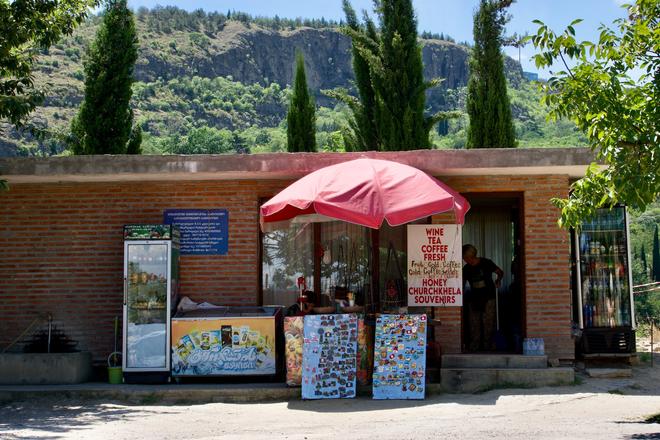
Services
Medical care, police:
You can call the fire brigade ambulance and the police on the universal number 112.
Tourist information:
The tourist information centre is located in the northern part of Freedom Square near Pushkin Park, and they will answer questions about transport around the city, give advice on where to go and where to stay, or give contact details for local guides and translators.
What to see
Rustaveli Avenue
The most important street in Tbilisi is Rustaveli Avenue, which is lined with government buildings, churches, theatres and museums. The Georgian Parliament Building with its distinctive columned facade should not escape your attention. The Soviet-directed building was constructed by German prisoners of war on the site of the Alexander Neveska Temple, which was demolished for the purpose of building the Parliament.
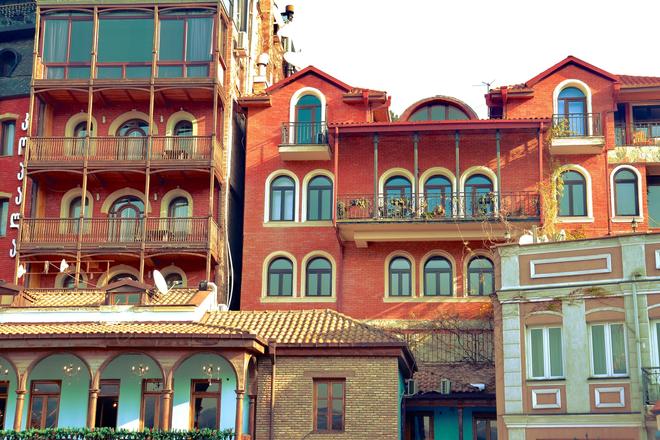
Across the street, I recommend a visit to the National Museum, which displays archaeological artifacts recounting the rich local history, from prehistoric times to the present day. The price of 7 GEL is more than reasonable, so if you have some time left, this place is definitely worth a visit. Don't miss the National Opera House, the Rustaveli State Academic Theatre, the Georgian Academy of Sciences, the Kashveti Church or the luxurious Biltmore Hotel.
Tbilisi Zoo was affected by devastating floods in 2015. Many may recall a photo of a hippo running through the city streets. Many wild animals, including big cats, escaped from the garden at that time. The zoo lost 300 residents as a result.
Freedom Square
The huge open space has had many names throughout history, becoming Freedom Square in 1918 to commemorate the establishment of the First Georgian Republic after the fall of the Tsarist regime in Russia. In 2006, a monument with a statue of St. George was erected in the centre, replacing the monument of V.I. Lenin, removed after the fall of the Soviet Union in 1991. Today, the square is the centre of public events, has seen several giant demonstrations, several meetings with world and local politicians and countless celebrations of this spirited nation, expressing the soul of the country, venting the emotions of the people.
However, the Norashen Monastery with the Jvaris Mama Church is especially worth a visit. The area takes you out of the busy street and offers a quiet and cosy island to relax and unwind from the busy and wild street. This gem of the Armenian Church was founded in 1467, the interior is decorated with beautiful frescoes, twilight and burning candles. The atmosphere of the place is best absorbed if you sit for a while in the courtyard of the complex.
Mtatsminda Amusement Park
Take a trip on a cogwheel to Mtatsminda theme park. The modernised carriages can load up to 60 people and run daily from 9am to 11.30pm. The panoramic view from the giant Ferris wheel costs about 3–5 GEL, but you can ride any of the park's rides, including the giant roller coaster. The best part of the hill, however, is the view of the city itself, which is unparalleled from the top of the cogwheel station.
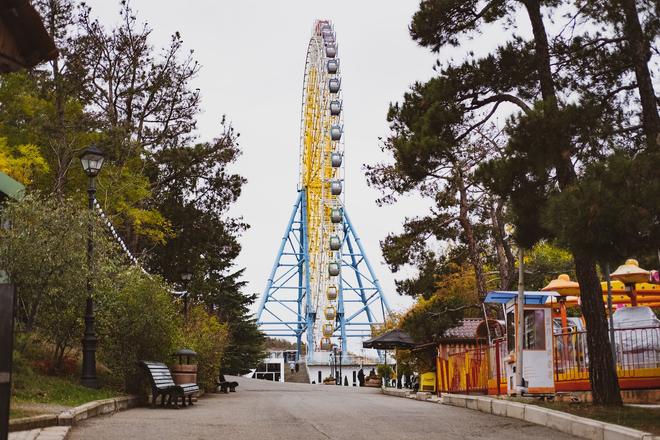
Holy Trinity Cathedral
There are also great views of the city of Tbilisi from the monumental Holy Trinity Cathedral on the left bank of the Mtkvari River. Although it may look ancient and well-maintained, construction of the 87-metre-high cathedral by architect Archil Mindiashvili only began in 1995. The architect has managed to create a magnificent shrine that, despite its short age, can proudly stand next to the old monasteries of the Orthodox Church, while being the third tallest building of the Orthodox Church in the world. The entire complex is made up of a large open, paved complex with wide views of the old city, and the park also offers grassy areas for resting. The only thing that can disturb the tranquility is the rather large number of visitors to the place.
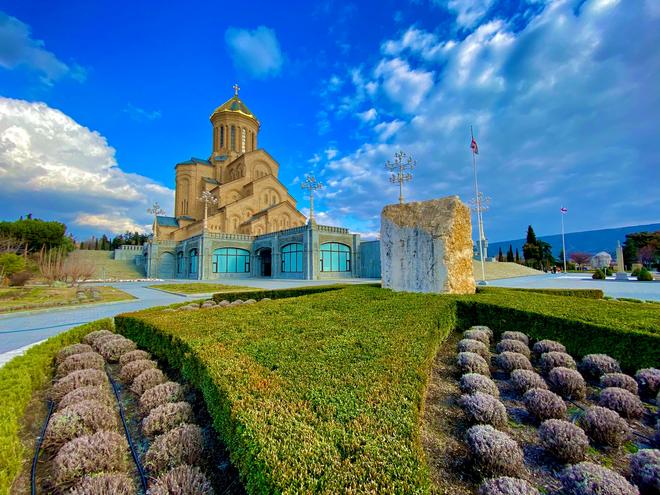
Contrast of old and new
At the beginning I mentioned the architectural contrast of old and new, which is most noticeable on the eastern bank of the Kura, which is reached from Meidan by the Metekhi bridge, where you will come directly to the feet of King Vakhtang. At the Rike park north of the bridge, perhaps the most noticeable buildings of Tbilisi's modern architecture are the glass Peace Bridge (opened in 2010) by Michele De Lucchi, which lights up beautifully every evening and adds to the light show of the whole of Tbilisi, and the mirrored concert tube hall Rhike (completed in 2016), designed by the Italian architects of the family-run Fuksas studio. The panorama is then completed by the glittering dome of the Presidential Palace in the background. It goes without saying that the construction of such distinctive buildings in the middle of an ancient city has caused a lot of controversy, but today this contrast is one of the typical elements that complete the face of the city.
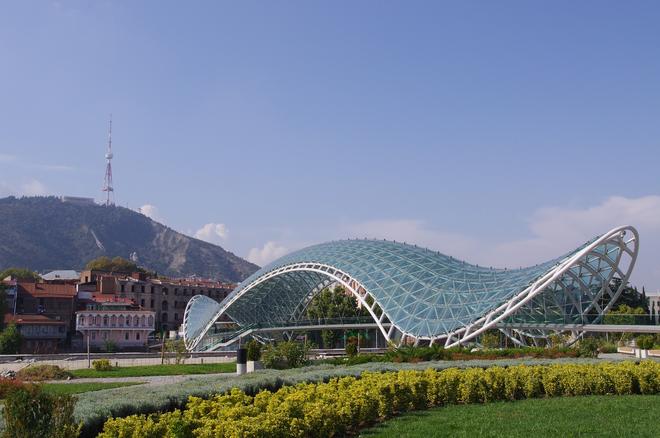
The hills above Tbilisi
Several different hills tower over the city, the most prominent being the Narikala Fortress on Sololaki Hill above the old town. From Rike Park you can travel up the hill by a panoramic cable car built in 2012. For 1 GEL it will take you high above Kura to meet the former 4th century Persian citadel. Today, the former fortress houses the Orthodox Church of St. Nicholas and an unforgettable view of the city on one side and the botanical garden on the other.
A few metres to the west you will walk along a path to one of the most famous monuments in Tbilisi, the statue of Mother Georgia, a monumental figure looking down on the city. It was erected in 1958 to celebrate the 1500th anniversary of the city's founding. As a symbol of Georgian distinctiveness, she holds in one hand a bowl of wine for those who come in peace. The right hand then holds a sword with which to "welcome" any enemies.
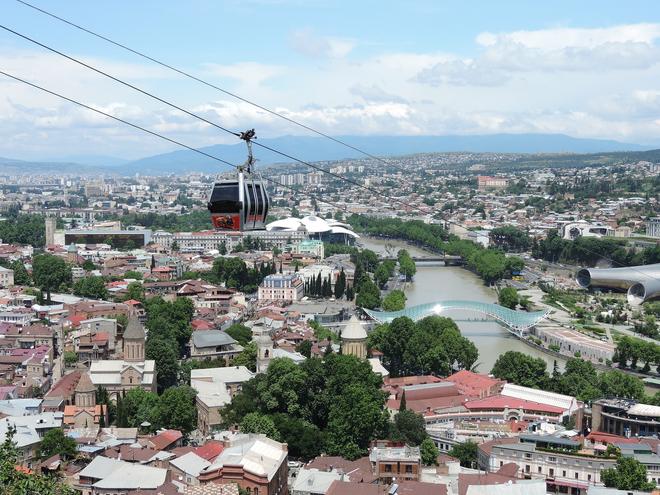
For those with a stronger stomach, I recommend the cable car ride, where the operator straps you into a colourful harness and sends you through the air on a 270-metre ride high above the botanical gardens. You can hook into the harness right next to Narikala.
Spa
After a day exploring Tbilisi, reward yourself with a dip in the sulphur baths. A natural spring of sulphate mineral water, which helps with musculoskeletal ailments and has beneficial effects on skin, vascular and nervous ailments, springs up in the Old Town area below Narikala Fortress.
Perhaps the most striking feature is the facade of the Orbeliani Baths, a mosaic symphony more typical of the madrasas of Central Asia, set between the brick facades of the old houses and the domes of the surrounding baths. It offers cheese baths and a drastic massage with scrubbing. Similar amenities are offered by Gulo's and the Royal Baths on the other side of the river that circles the Orbeliani.
If you head upstream into the steep canyon, you will reach the Dzveli waterfall, an oasis of calm in the middle of the old town.
Trips to the surroundings
The former capital of Georgia is Mcchteta, which has a beautiful historic centre. It can be reached from Tbilisi by shuttle bus, which departs several times an hour from Didube and costs about 1 GEL.
Above the confluence of the Mtkvari and Aragvi rivers, the Jvari Monastery (Temple of the Cross) towers here, which remains one of the most important symbols of Georgia to this day. In the middle of the small town of Mtskheta you will find the Cathedral of the Life-giving Columns, which was inscribed on the UNESCO World Heritage List together with the town in 1996.
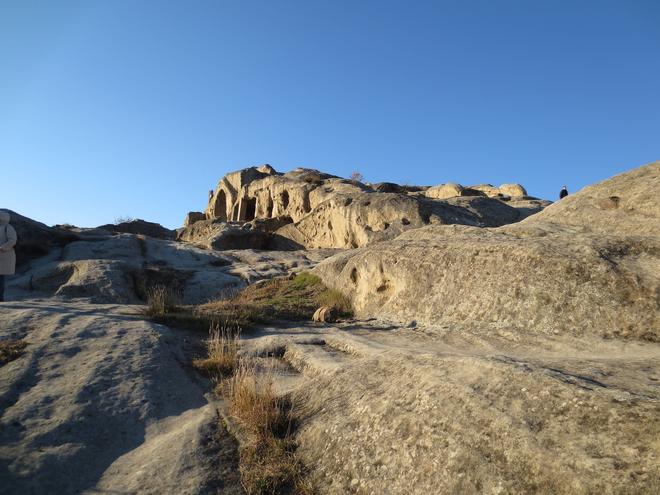
You can take a day trip from Tbilisi to Gori, the birthplace of Stalin. Visit Stalin's house, the museum and Stalin's train. The dominant feature of the city is the Gori Fortress. Nearby you will find the prehistoric rock city of Uplistsikhe with a history dating back to several hundred years before Christ.
As well as to Mtskheta, marshutkas run to Gori every now and then from Didube station.
Culture and holidays
Every October, the city hosts Tbilisoba, a festival celebrating the city's history and diversity that has been a tradition since 1979. Tbilisboa takes place in Rike Park, on Meidan and in the surrounding streets, and many people from all over Georgia come here to showcase their region and display the best of it, including traditional music, costumes, dances, food and the sale of all kinds of trinkets and products. Regions also present their wine here.
Interesting fact at the end
The town was named after the hot healing springs that spring from the bedrock on the northeastern part of Mount Tabori. The name therefore comes from the Georgian tbili, or warm. The baths here form part of the national heritage. Until 1936 the town was known as Tiflis, derived from the town's patron saint, the Christian martyr Saint Abo of Tiflis, whose burial place is said to be on the cliff below the temple of Metechi.
